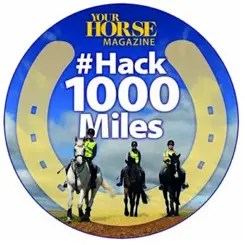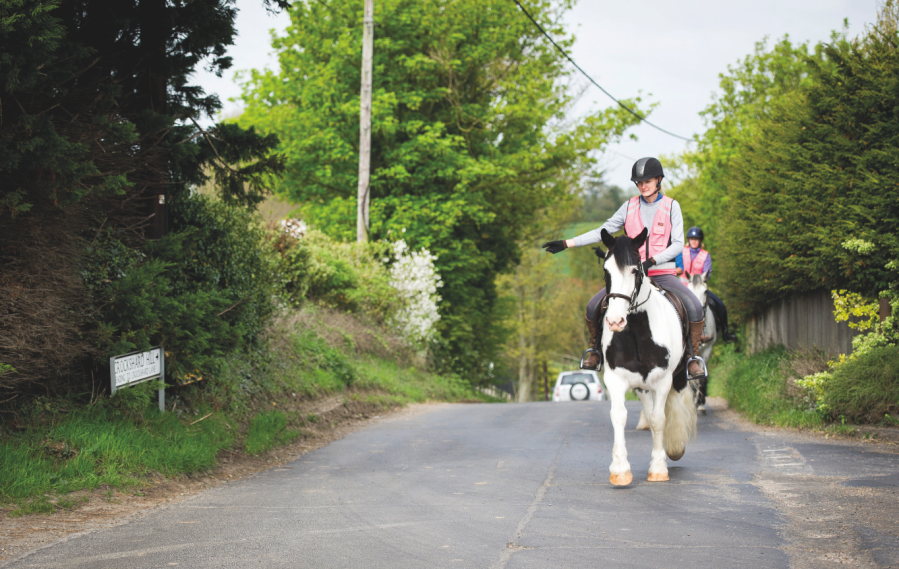Changes to The Highway Code came into effect in the UK on 29 January 2022 and affect everybody who enjoys hacking a horse on the road. The changes created a “hierarchy” of road users based on the principle that those who are likely to cause greater harm should have more responsibility to reduce the danger that they pose to more vulnerable road users. The aim is to give clearer and stronger priorities for vulnerable road users, including pedestrians, cyclists and horse riders, who are considered to be most likely to be injured in the event of a road collision.
 Horse riders and drivers of horse-drawn vehicles appear second most vulnerable in The Highway Code’s hierarchy of road users. They rank as less vulnerable than pedestrians and equal with cyclists, but more vulnerable than motorcyclists, cars, vans, minibuses, large passenger vehicles and goods vehicles. Therefore, the changes impose a responsibility on motorists to take greater care to reduce the danger they pose to horse riders and horse-drawn vehicles. Horse riders and horse-drawn vehicles have a similar responsibility to reduce danger to pedestrians.
Horse riders and drivers of horse-drawn vehicles appear second most vulnerable in The Highway Code’s hierarchy of road users. They rank as less vulnerable than pedestrians and equal with cyclists, but more vulnerable than motorcyclists, cars, vans, minibuses, large passenger vehicles and goods vehicles. Therefore, the changes impose a responsibility on motorists to take greater care to reduce the danger they pose to horse riders and horse-drawn vehicles. Horse riders and horse-drawn vehicles have a similar responsibility to reduce danger to pedestrians.
Of course, the changes do not mean that horse riders (and other vulnerable road users) do not need to consider the safety of road users who are deemed less vulnerable than they are. All road users must have regard for their own and others’ safety.
The Highway Code: rules for horse riders
It was previously a requirement for all horse riders to ensure that a) their tack fits well and is in good condition and b) that they can control their horse. The recent changes to The Highway Code have extended that obligation to drivers of horse-drawn vehicles also.
The new rules keep the existing recommendation to ride with a less nervous horse if you think that your horse will be nervous of traffic, and to never ride without a saddle and bridle. The changes to the rules also add the following recommendation: “If you are an inexperienced horse rider or have not ridden for a while, consider taking the Ride Safe Award from the British Horse Society. The Ride Safe Award provides a foundation for any horse rider to be safe and knowledgeable when riding in all environments but particularly on the road.”
Negotiating roundabouts
In respect of roundabouts, horse riders and horse-drawn vehicles are directed to stay in the left-hand lane of the roundabout and to signal right to show that they do not intend to leave the roundabout, despite being in the left-hand lane. It also states that roundabouts should be avoided whenever possible and to signal left when you are leaving the roundabout.
Motorists are warned not to cut across horse riders and horse-drawn vehicles in the left-hand lane when exiting the roundabout. Learn more about roundabouts and crossing junctions out hacking here.
Narrow sections of road
New rule 213 provides that on narrow sections of road, horse riders may, if they wish, ride in the centre of the road and that motorists should allow them to do so for their own safety and to ensure that they can see and be seen. On narrow roads, motorists are also now required to allow horse riders and horse-drawn vehicles plenty of room to manoeuvre to avoid uneven road surfaces or obstacles.
The Highway Code: rules for cyclists
The rules provide that cyclists should give way to horse riders on a bridleway. Cyclists are asked to be particularly aware when riding in spaces which are shared with pedestrians, horse riders and horse-drawn vehicles. They are advised to slow down when necessary if passing another road user, and to let them know that they are there by ringing their bell or calling out politely. They are told not to pass other road users closely or at speed, particularly from behind, and that they should never pass a horse on its left.
A specific warning is given in the rules that horses can be startled if passed without warning and cyclists are advised to always be prepared to slow down and stop when necessary. They are told not to cross at an equestrian crossing, and to dismount and wheel their bike across a pelican, puffin or zebra crossing.
The Highway Code: rules for motorists
Motorists are advised the following when they meet a horse rider or horse-drawn vehicle on the road:
Cutting across
Motorists should not cut across horse riders or horse-drawn vehicles when turning into or out of a junction, or when changing direction or lane. Drivers are directed that they should not turn at a junction, if doing so would cause the horse rider or horse-drawn vehicle to stop or swerve.
Overtaking a horse rider
New rules are given in The Highway Code in respect of overtaking a horse being ridden, led or driven on the road. As a guide, motorists are told to pass horse riders and horse-drawn vehicles at speeds under 10 miles per hour and to allow at least two metres of space, and as much space as they would give when overtaking a car. This is an improvement on previous guidance, which did not specify the speed at which motorists should pass, nor did it give a clear distance which they should give between them and the horse.
Waiting behind a horse rider
Motorists are told to stay behind if they are following a horse rider or horse-drawn vehicle approaching a roundabout or junction, and the motorist intends to turn left, so as not to cut across a horse rider or horse-drawn vehicle.
Reducing speed around a horse
The new rule 125 reminds road users that inappropriate speeds are intimidating, and will deter people from walking, cycling or riding horses. Drivers are told that they must always reduce their speeds when sharing the road with pedestrians, cyclists, horse riders, horse-drawn vehicles and motorcyclists.
Looking over their shoulder
New rule 212 reminds motorists that they should take extra care when driving in bad weather and at night, and that if a rider looks over their shoulder, it could be because they intend to change direction or pull out and they should be given the time and space to do so.
Be patient
New rule 215 states that upon seeing a horse rider or horse-drawn vehicle, the motorist must be patient, not sound their horn or rev their engine. Motorists are advised that horses are flight animals and can move incredibly quickly if startled.
Passing wild ponies
A specific warning is given to motorists to take care regarding areas where feral or semi-feral ponies can be found including the New Forest, Exmoor and Dartmoor.
The Highway Code: summary and legal status
Overall, the changes to The Highway Code appear to affect cyclists (and their relationship with other road users) more so than horse riders and horse-drawn vehicles. However, it must be said that a number of helpful rules have been imposed to increase the burden on motorists to avoid the risk of accident when interacting with horses.
It remains to be seen what impact the new rules will have on a practical level. There are concerns that many road users on the whole are not familiar with The Highway Code, as it was, or is now.
The Highway Code is not a law in itself. However, if some of the mandatory rules are disobeyed, then a criminal offence may be committed. Failure to comply with The Highway Code alone will not, of itself, cause a person to be prosecuted, but The Highway Code can be used as evidence in Court proceedings to prosecute an individual for traffic offences, such as breach of the Road Traffic Act.
How to report a breach of The Highway Code
You can report non-emergency breaches of The Highway Code or other road safety offences by calling 101. If and when you do so, you should provide as much information as possible, including the driver’s number plate, a description of the vehicle and the driver, the time, date and location of the incident, video or photographic evidence and any independent witness evidence.









